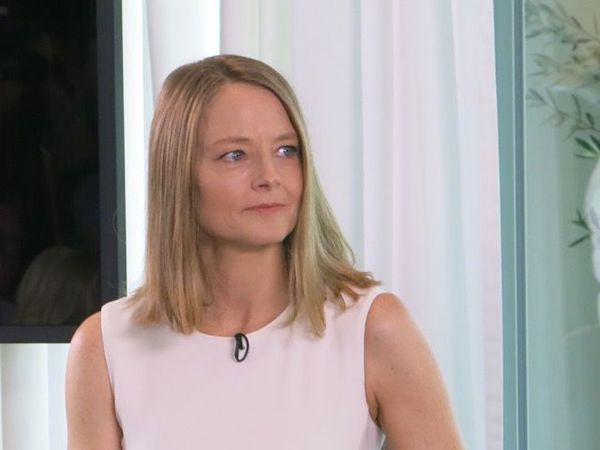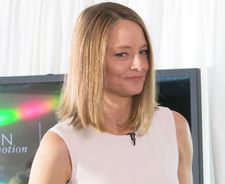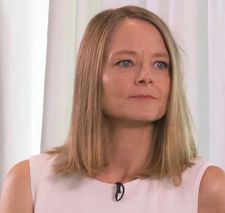 |
| Jodie Foster: "Everything changed when women came on the scene." Photo: Richard Mowe |
Jodie Foster, who is back at the Cannes Film Festival more than 40 years after she first appeared aged 12 in the controversial Taxi Driver by Martin Scorsese, recalls she wanted to be a film director from an early age.
The director of Money Monster, a financial thriller with George Clooney and Julia Roberts, screening out of competition, was the first candidate in the Women in Motion sessions sponsored by luxury goods brand Kering in a suitably swanky suite atop the Majestic Hotel.
Foster, 53, looked cool and elegant in a simple shift dress in pale pink. After starring in dozens of films, from Freaky Friday in 1976 to Silence Of The Lambs (1991), Contact (1997) and Panic Room in 2002, she has now decided to focus on her work behind the camera.
 |
| "I see I confuse people because I am so direct." Photo: Richard Mowe |
She said: “I am not a spokesman for anything but I have been in the business for 50 years and have seen drastic changes. As a child I never saw another woman on set except the lady who played my mom.
“I saw faces change as time went on and that was extraordinary. There used to be only men on movie sets ambling around and getting in to trouble. Everything changed when women came on the scene and they brought their sons and daughters and it was like a family. Film sets became healthier. But directing for mainstream movies has not really changed although the independent sector and television have a healthier representation of female directors.”
Foster suggested that studio executives were running scared because of the economy and the structure of the studios. “Women are considered too great a risk,” she said.
This is despite the fact that women buy 51 per cent of movie tickets. “But perhaps they buy tickets to see all those wonderful guys on the screen. It is always a complex discussion when you are dealing with an art form,” said Foster. “We are not a factory making shoes so the rules are going to be different. There are so many issues about lack of diversity in our culture and the media and film and TV are reflection of that.”
Part of the problem, she suggested, was that studios poured their money into blockbusters and event films to get in as many people as possible. “That is a dangerous bet but it is the way it seems to be heading now,” she added.
Citing such European female directors as Lina Wertmuller and Liliana Cavani as influences, Foster praised the support she received from her single parent mother and her agents.
“My agents were incredibly supportive. They were proud of me and worked with me as a child. They trusted me and gave me opportunities nobody should have given me. There was support from male directors too who saw me as their daughter and suddenly I was in that boys’ club.”
 |
| "I had never worked with George before... He's got a great attitude." Photo: Richard Mowe |
She has only worked with only one female director, Mary Lambert on Siesta, opposite Ellen Barkin in 1987. “I wasn’t trying to avoid women directors but there just weren’t any at the time.
“It was an art film, and very visual. I misbehaved but I was only 23 or 24. I needed somebody to change my behaviour. Mary took me aside and said you cannot do that. I was being disrespectful because I was turning up late. Now I am never late. She took me aside and at that age I really listened and I never did it again. She sat me down as a person and talked to me. Good ‘parenting’ more often comes from a female director and it is also a question of leadership style.
“So there are differences and I see I confuse people because I am so direct. I was not taught not to be direct. I am not a bully and will not respond to that. I do not have the personality to punch back. Often men do not know how they should handle women. It is about people in the playground trying to get their way. Men are confused by women who do not follow traditional roles in conflict.”
Foster sees signs of hope. “The film industry is a progressive world and people want to change but they are stuck with some of the same traditional models and do not know how to get round them,” she added.
She regards herself as fortunate working in an environment where she can juggle the demands of motherhood [she has two teenage boys] and career. “I had a real luxury to have an acting career that allowed me adaptability. I would chose to do movies in New York or LA or Paris. I could work once in three years and I had a lot of choices as an actor you do not have as a director. I waited 12 years until my kids were old enough. I was scared to leave my life with my children and I just did not work in those years. Actually I did have one movie but it fell apart.
“Men have been making those decisions and some barely see their children and sacrifice their family. All these guys never saw their children. They accepted it because they thought that was their role.”
The attraction of her new film, she said, was that it is not just a genre movie but a film about characters. It is fast paced and has big stars. I worked on script for two-and-a-half years and changed a lot of stuff.
“I had never worked with George before. He is a regular guy who is able to be nice to everyone. He’s got a great attitude.”
 |
| " I see myself in all of my characters, including the men." Photo: Richard Mowe |
She found the financial world fascinating. She felt it was good for people to be aware of what is being done to them. She suggested: “Take your lessons through the characters and not through the politics of the film.”
Asked how she felt about quota systems to ensure women have a proper place in the system she replied diplomatically: “I would be interested to see how such an experiment does but I am worried about quotas in terms of art which might put back the cause rather than advance it.”
When she was younger she was always being told that by time she was 40 she would never work again. “It was not true for me. I know there are many scripts out there for diverse women but they are not getting to the screen. It is simply a financial issue where art and commerce are coming together and commerce is winning.”
She finds it perfectly natural to be able to put herself in the skin of her male characters. “Everything you do creatively is a piece of your culture and where you come from. I see myself in all of my characters including the men. I put myself in their bodies and psyches. I have a male side of myself.”
Frequently male directors were unable to make such a transition the other way and to understand their female characters.
Foster has always wanted to make a period film – which may be next on the agenda. “I think every movie I make sometimes is a reaction to the last one. So I imagine I’ll do something very different from this one.”
And with that, her mission was done and she was gone, surrounded by a flurry of minders.
Money Monster is released in the UK on May 27. Many European territories including France and Italy from May 12.
Cannes Film Festival premiere tonight (May 12)





















